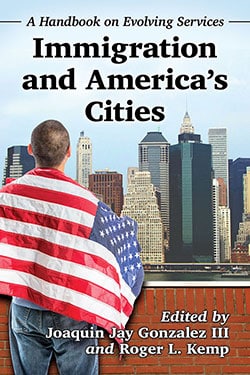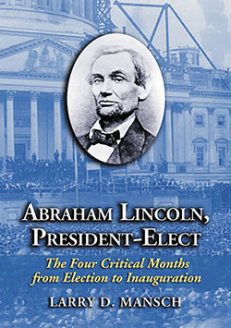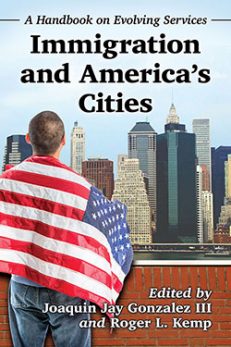Immigration and America’s Cities
A Handbook on Evolving Services
Original price was: $39.95.$19.99Current price is: $19.99.
In stock
About the Book
Generations ago, immigrants came to the U.S. from Europe and Africa in large numbers. Today they are arriving mainly from Latin America and Asia. Most are documented but many are not. While the federal and most state governments have done little beyond controlling borders and ports of entry to address pressing immigration issues, public officials and community organizations at the local level have been advancing commonsense, pragmatic solutions to accommodate the newest members of American society. This collection of essays provides a handbook for developing good county- and municipal-level immigrant services. The contributors cover a diverse range of trends, issues and practices, including immigration reform, language access, identification and driver’s licensing, employment, education, voting, public safety and legal assistance.
About the Author(s)
Bibliographic Details
Edited by Joaquin Jay Gonzalez III and Roger L. Kemp
Format: softcover (6 x 9)
Pages: 312
Bibliographic Info: appendices, notes, bibliographies, index
Copyright Date: 2016
pISBN: 978-0-7864-9633-4
eISBN: 978-1-4766-2379-5
Imprint: McFarland
Table of Contents
Acknowledgments vi
Preface 1
Part I—Trends and Issues
1. Second Immigration Wave Lifts Diversity to Record High (Greg Toppo and Paul Overberg) 6
2. Immigrant Population Growing Faster Than Natives in Metro Areas (Mike Maciag) 12
3. Asian Immigrant Numbers Surpass Latino Numbers (Rebecca Trounson) 16
4. Not-So-Comprehensive Immigration Reform (Samuel Kleiner) 19
5. Costs Mount for Counties as Immigration Reform Languishes (Charles Taylor) 22
6. For Mayors, It Is About Integration, Not Immigration (Paul Pontieri) 25
7. The Immigration Debate We’re Not Having (Susan K. Urahn) 28
8. It’s Okay That Congress Won’t Act on Immigration (Cristina Rodriguez) 30
9. Elderly Immigrants in the United States (Paola Scommegna) 33
Part II—Practices and Experiences
• Section A: Safe Havens and Open Doors •
10. A Safe Haven in New Haven (Michele Wucker) 46
11. Philadelphia’s Open-Door Immigrant Policy (Tod Newcombe) 49
12. Make San Francisco a Sanctuary for Illegal Immigrants (Peter Fimrite) 51
13. Looking the Other Way on Immigrants (Anthony Faiola) 53
• Section B: Language Access •
14. How Language Fits Into the Immigration Issue (Ryan Holeywell) 57
15. Wanted: Language and Cultural Competence (Elizabeth Kellar) 63
16. Providing Language Access Services in a Global Economy (Anuj Gupta and David Torres) 71
17. Tips for Testing and Certifying Multilingual Employees (Jason Reed) 78
• Section C: Identification Card and Driver’s Licensing •
18. Welcome Mat (Rob Gurwitt) 83
19. Who We Are (Center for Popular Democracy) 91
20. Driver’s Licenses Will be “An Incredible Relief”(Kate Linthicum) 99
• Section D: Employment •
21. Toil and Trouble (Jonathan Walters) 103
22. Business and Labor Unite to Try to Alter Immigration Laws (Steven Greenhouse) 111
23. Georgia Immigration Law: Many Agencies Fail to Comply (Jeremy Redmon) 114
• Section E: Business and Investment •
24. Immigrant Investors: A New Source of Real Estate Capital (Alex Hutchinson) 119
25. City of Bellevue Recognized as Immigration Trend-Setter (International City/County Management Association) 127
• Section F: English Language Learners •
26. Bilingual Vocational Education for Immigrants (Cheryl Harrison) 129
27. The Case for Structured English Immersion (Kevin Clark) 134
28. New Immigrant Populations Recreating Community (Thomas C. Reynolds) 142
29. Linking to Prior Learning (Yu Ren Dong) 145
• Section G: Education and Literacy •
30. Keeping the Dream Alive (Julie Bell) 153
31. In-State Tuition and Unauthorized Immigrant Students (Ann Morse) 160
32. Financial Literacy Programs for Immigrants (Jamie Durana) 165
• Section H: Library Services •
33. New Immigrants Center at the Austin Public Library (Diana Miranda-Murillo) 170
34. Librarian’s Toolkit for Responding to Anti-Immigrant
Sentiment (Robin Imperial) 177
• Section I: Civic Engagement and Voting •
35. Immigrant-Friendly Cities Want What Arizona Doesn’t (Dylan Scott) 181
36. Serving Diverse Communities—Best Practices (Julie C.T. Hernandez, John C. Brown and Christine C. Tien) 187
37. Courting the Filipino American Immigrant Vote (Joaquin Jay Gonzalez III) 196
• Section J: Policing and Public Safety •
38. Community Policing in the Delray Beach Haitian Community (Anthony Strianese) 207
39. Local Authorities in Fight with Feds About Enforcement (Kate Linthicum) 210
• Section K: Legal Assistance •
40. New York Gives Legal Counsel to Undocumented Immigrants (Cindy Chang) 213
41. Obama Faces Growing Rebellion Against Secure Communities (Elise Foley) 216
• Section L: Seniors and Healthcare •
42. Emerging Challenge for the U.S. Healthcare System (Emmanuel Gorospe) 223
43. Illegal Immigrants Most Helped by Emergency Medicaid (Phil Galewitz) 230
Part III—The Future
44. The Rise of the New Baltimoreans (Nancy Scola) 236
45. Immigrants Countering Population Losses in Many Metro Areas (Mike Maciag) 244
46. Extend Health Insurance to Unauthorized Immigrants? (J.B. Wogan) 247
47. Selected State Reports on the Impact of Immigrants (Jiashan Cui) 249
Appendices
I. United States Conference of Mayors’ March 12, 2014, Letter to Congress 264
II. National League of Cities’ Resolution in Support of Comprehensive Immigration Reform 267
III. National Association of Counties’ Call to Action: Support Comprehensive Immigration Reform 270
IV. Arlington County Board Resolution Welcoming Arlington’s Newcomers 273
V. President Barack Obama’s 2014 Executive Action on Immigration Speech 275
VI. San Francisco Mayor Ed Lee’s Executive Directive on Immigration 280
VII. List of Sanctuary Cities 283
VIII. Guidelines for Developing a Language Access Plan 285
IX. Federal Benefits Available to Unauthorized Immigrants 287
X. National Immigration Resource Directory 289
About the Editors and Contributors 291
Index 295
Book Reviews & Awards
- “a wealth if information on how American cities are dealing with immigrants…a valuable resource for those seeking solutions to immigration issues”—ARBA
- “Gonzalez and Kemp provide a timely accounting of how local communities grapple with vexing immigration issues, providing useful guidance for state and federal policymakers.”—Evert W. Palmer, MPA, ICMA-CM, City Manager, City of Folsom, California
- “This country was built by immigrants…hence community organizations have a responsibility to serve them.”—Steve Nakajo, Executive Director, Kimochi Senior Centers
- “Gonzalez and Kemp empower immigrants by making them aware of the grassroots programs developed by local government units to help them settle into their new lives.”—Henry S. Bensurto, Jr., Consul General of the Philippines; “A much-needed down-to-earth compilation.”—Rhacel S. Parreñas, University of Southern California
- “Gonzalez and Kemp have pulled together practical, nuts-and-bolts examples of how cities are tackling the challenge of providing services to their diverse populations.”—Patrick Murphy, Director of Research and Senior Fellow, Public Policy Institute of California
- “Gonzalez and Kemp have the pulse on how innovative cities and communities are creating welcoming places where immigrants can thrive and contribute.”—Adrienne Pon, Executive Director, Office of Civic Engagement & Immigrant Affairs, City and County of San Francisco
- “This book makes it clear that without a deep understanding of immigrant issues, it is impossible to make informed decisions and build trust with societal groups that often leave crime unreported.”—Paul Figueroa, Local Law Enforcement Executive
- “Gonzalez and Kemp provide invaluable insights on how cities are stepping up to the challenge of creating greater opportunities for immigrants at a time when partisan gridlock in Congress is the worst ever.”—Christopher Punongbayan, Executive Director, Advancing Justice-Asian Law Caucus







